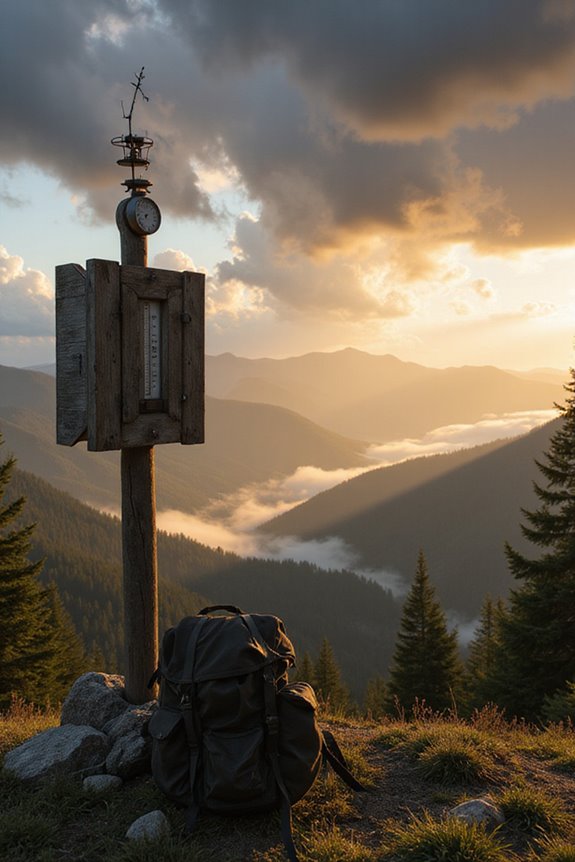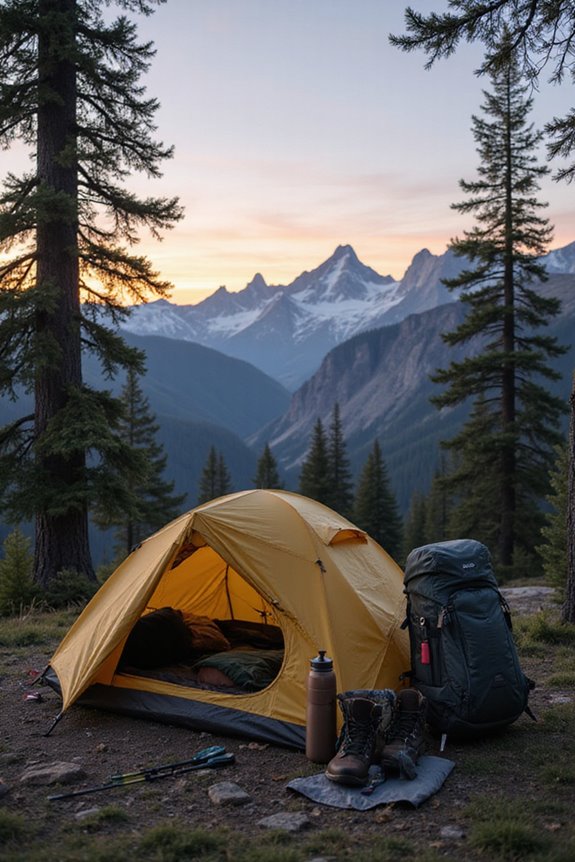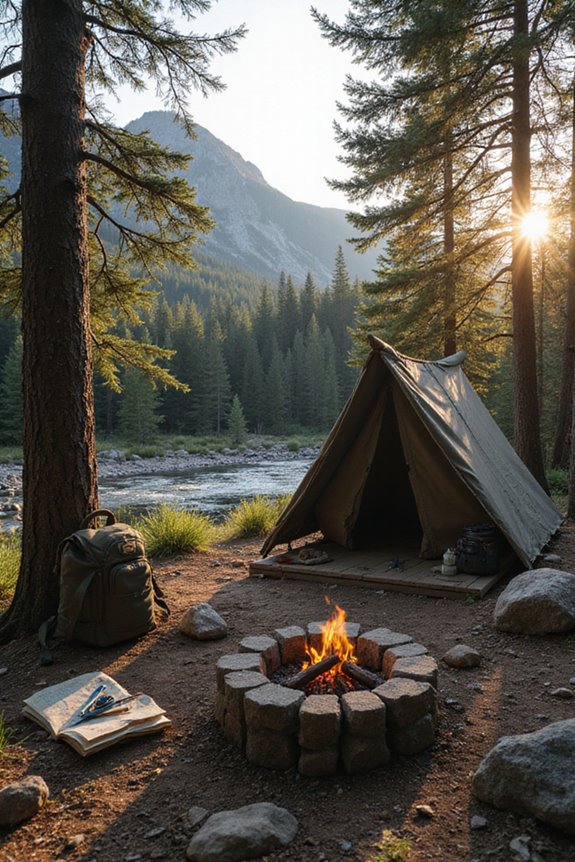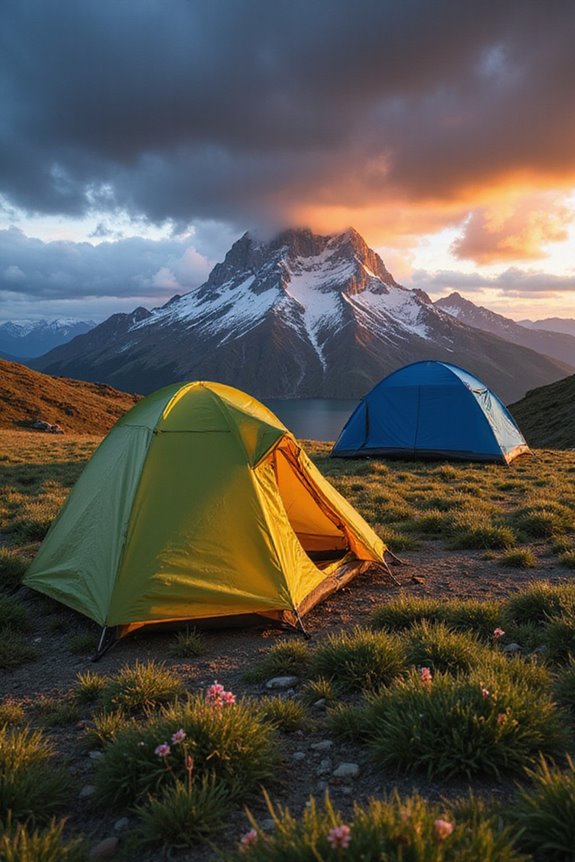When I plan outdoor trips, I always start by checking reliable weather websites and apps for the latest forecasts, particularly for temperature and precipitation. I like to keep an eye on things like wind conditions and UV indexes too—trust me, sunburn is not fun! I prepare for sudden changes by packing lightweight waterproof jackets. Knowing all this keeps my adventures safe and enjoyable. Curious about more weather tips? There’s plenty more to discover!
Key Takeaways
- Check reputable national weather websites and apps for accurate forecasts tailored to your outdoor activity.
- Monitor temperature trends and precipitation patterns to determine appropriate clothing and gear.
- Utilize radar technology for real-time tracking of precipitation and cloud movements.
- Be aware of local microclimates and sudden weather shifts to prepare for changing conditions.
- Sync your outdoor plans with forecasts, adjusting for safety and comfort based on predicted weather.
Understanding Key Weather Terms
When it comes to planning an outdoor trip, you might find yourself scratching your head over all those weather terms flying around. I know I did! Let’s break it down. First up, temperature fluctuations can really change the vibe of your adventure. Ideal hiking temps sit between 50°F and 80°F; anything outside that range can lead to heat exhaustion or chills. Then, there’s precipitation types, which can make or break your plans. A forecast of steady rain means you’ll want that waterproof gear, while those pesky pop-up showers? They’re a gamble! Trust me, understanding these terms helps me choose the right clothes and gear, ensuring I’m comfortable and safe on my trips. So, let’s get to forecasting like pros!
Utilizing Tools for Accurate Forecasting

While planning an outdoor trip, I’ve learned that utilizing the right tools for accurate weather forecasting can make all the difference in the world. I always start by checking reputable national weather websites, especially those that offer customizable maps for remote areas. Then, I turn to my trusty weather apps, which give me tailored forecasts for hiking or camping. I can track sunburn risks or allergy alerts—super handy! Radar technology is a game-changer too; it helps me monitor real-time precipitation and cloud movements. By combining these tools, I feel more prepared and less anxious about unexpected weather surprises. So, whether it’s sunny skies or storm clouds, having these resources at my fingertips gives me peace of mind!
Monitoring Essential Weather Factors

As I plunge into planning my outdoor adventures, keeping an eye on essential weather factors is key to ensuring a smooth and enjoyable experience. I always start with temperature trends—checking the highs and lows helps me gauge what to wear. For instance, I know running feels great between 50°F and 60°F, but extreme temps can throw a wrench in my plans. Then, I look at precipitation patterns; even a slight chance of rain can turn a sunny hike into a slippery mess. I also factor in the wind—strong gusts can make kayaking a bit too thrilling! And let’s not forget about sunlight and humidity; they can either make or break my day outdoors. So, I stay prepared!
Incorporating Forecasts Into Activity Planning
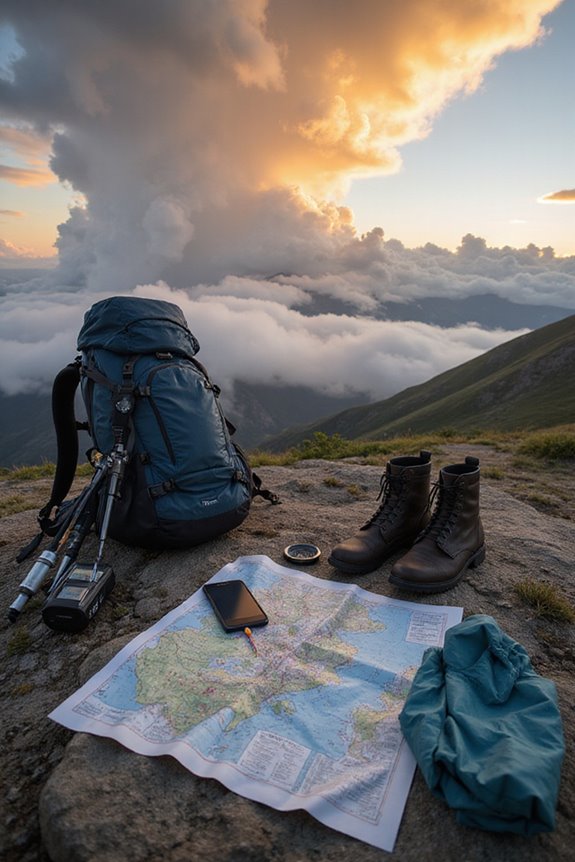
Planning an outdoor trip isn’t just about picking a pretty spot; it’s about syncing your adventure with the weather forecast. Trust me, I’ve learned the hard way that forecast accuracy can make or break your plans! I always check forecasts to align my activity scheduling with ideal weather, ensuring I’m not sweating buckets or braving a downpour. I love planning hikes around sunrise and sunset times, soaking in the beauty while staying safe. If thunderstorms loom, I’ve got indoor options ready—nobody wants to be caught in a storm! Plus, I keep an eye on UV indexes to choose shaded spots. Adapting my gear based on the forecast? Essential. After all, a great trip starts with smart planning!
Interpreting Weather Data for Safety
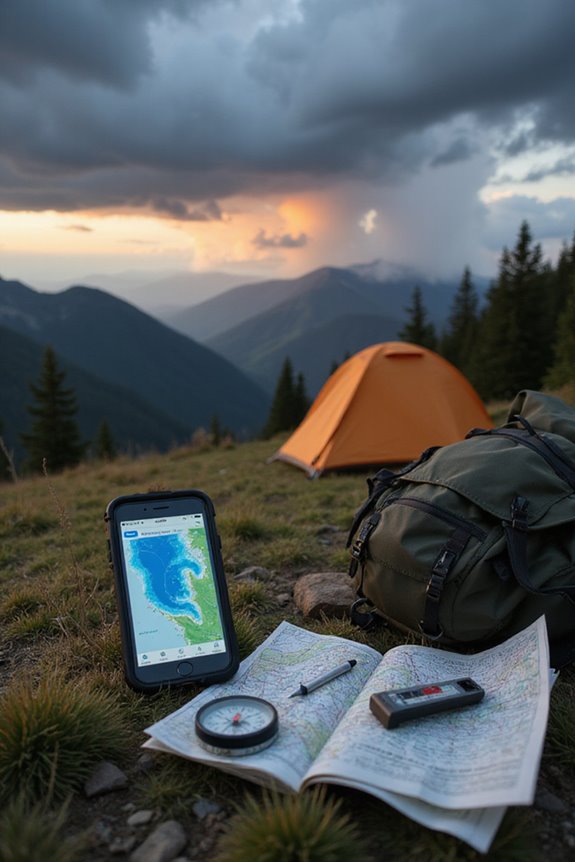
When it comes to outdoor adventures, interpreting weather data isn’t just a nice-to-have; it’s a game changer for safety. I’ve had my share of trips where ignoring weather alerts led to some close calls. For instance, that time I hiked during a fire weather watch—I learned the hard way how quickly conditions can change. Keeping an eye on severe weather warnings is essential, as they tell us when to pack it up or seek shelter. Remember to check the wind chill index too; it’ll help you avoid hypothermia. And don’t forget the UV index; sunburn can sneak up on you! By understanding these details, I can better plan my outings and prioritize safety precautions, ensuring I enjoy my adventures to the fullest.
Enhancing Your Outdoor Experience With Weather Intelligence
While I’ve always loved the thrill of outdoor adventures, I’ve learned that understanding the weather can take my experiences from good to unforgettable. For instance, I once brought my fishing gear out only to be greeted by unexpected rain. Now, I rely on portable weather instruments to track temperature, humidity, and wind speed, ensuring I’m always prepared. Monitoring localized weather data helps me pick the best times for activities, like hiking or barbecuing, maximizing my outdoor enjoyment. Plus, sharing this info with friends keeps us all in sync. By anticipating weather patterns, I can adjust plans, avoid storms, and make the most of every outing. Trust me, a little weather intelligence goes a long way in creating memorable adventures!
Preparing for Sudden Weather Changes
Sudden weather changes can catch anyone off guard, but I’ve learned the hard way that being unprepared can turn a fun trip into a scramble for cover. I remember a hike where a sunny morning morphed into sudden temperature drops and rapid precipitation events. It was like nature flipped a switch! Now, I always carry a lightweight waterproof jacket and thermal layers, just in case. I also keep an eye on the wind and cloud formations, especially those ominous cumulonimbus clouds that signal trouble. Plus, I make sure someone knows my plans—just in case I need to retreat quickly. Staying aware of my surroundings and the local microclimates has saved me more than once; it’s all about being ready for anything!
Choosing the Right Time for Outdoor Activities
Choosing the right time for outdoor activities can make all the difference between a memorable adventure and a day spent battling the elements. I’ve learned that timing strategies are essential—like hitting the trails in the early morning when temperatures hover around 60°F to 70°F. It’s perfect for hiking! Seasonal considerations matter too; spring might tempt you with blooms, but those pesky rain showers can sneak up. In summer, I try to avoid midday heat, opting for late afternoons when the sun’s a bit kinder. Watching wind conditions helps, especially for cycling. And let’s not forget about the UV Index—slather on sunscreen during those sunny excursions! Planning around these factors means more fun and fewer surprises. Additionally, using a high SPF sunscreen stick can provide long-lasting protection during your outdoor adventures.
Assessing Health-related Weather Risks
Ever wondered how the weather can turn a fun outdoor trip into a health scare? It can happen faster than you think! Heat stress, for instance, is a real danger, especially for vulnerable populations like older adults and those with chronic health issues. I remember a hiking trip where the sun blazed down relentlessly, and a friend nearly collapsed from heat exhaustion. It was a wake-up call! We need to stay alert to heat advisories and make hydration a priority. Taking breaks in the shade, wearing breathable clothing, and knowing the signs of heat illness can save lives. So, before you head out, consider who’s in your group and their health status; it could be the difference between an adventure and a health scare!
Frequently Asked Questions
How Can I Access Local Weather Updates Quickly?
I usually access local weather updates quickly through dedicated weather apps. They provide real-time forecasts and alerts, ensuring I’m informed about any changes. It’s essential for planning my outdoor activities effectively and safely.
What Should I Do if Forecasts Differ From Actual Weather?
If forecasts differ from actual weather, I always prioritize safety precautions, adjusting plans as needed. I shorten trips or alter routes, ensuring I’m prepared for unexpected conditions by carrying extra gear and supplies.
How Can I Interpret Weather Alerts Effectively?
As dark clouds loom, I sift through weather terminology, grasping alert categories. Warnings scream urgency, watches whisper caution, while advisories gently nudge awareness. Understanding these nuances helps me navigate nature’s whims with confidence and safety.
Are There Specific Apps for Tracking Severe Weather?
Yes, I’ve found several severe weather apps that use advanced tracking technology. The Weather Channel and AccuWeather are my favorites; they provide real-time alerts and detailed radar, helping me stay prepared for any extreme weather.
How Do Weather Patterns Differ by Season?
I’ve noticed that spring weather can bring unpredictable storms, while winter storms often lead to heavy snowfall and icy conditions. Understanding these seasonal differences helps me prepare for various outdoor experiences throughout the year.

